
List of Dukes and Grand Dukes of Mecklenburg
Encyclopedia

Germany
Germany , officially the Federal Republic of Germany , is a federal parliamentary republic in Europe. The country consists of 16 states while the capital and largest city is Berlin. Germany covers an area of 357,021 km2 and has a largely temperate seasonal climate...
princely state of Mecklenburg
Mecklenburg
Mecklenburg is a historical region in northern Germany comprising the western and larger part of the federal-state Mecklenburg-Vorpommern...
's royal house in the High Middle Ages
High Middle Ages
The High Middle Ages was the period of European history around the 11th, 12th, and 13th centuries . The High Middle Ages were preceded by the Early Middle Ages and followed by the Late Middle Ages, which by convention end around 1500....
to the monarchy's abolition at the end of World War I
World War I
World War I , which was predominantly called the World War or the Great War from its occurrence until 1939, and the First World War or World War I thereafter, was a major war centred in Europe that began on 28 July 1914 and lasted until 11 November 1918...
. Strictly speaking, Mecklenburg’s princely dynasty was descended linearly from the princes (or kings) of a Slavic tribe, the Obotrites
Obotrites
The Obotrites , also commonly known as the Obodrites, Abotrites, or Abodrites, were a confederation of medieval West Slavic tribes within the territory of modern Mecklenburg and Holstein in northern Germany . For decades they were allies of Charlemagne in his wars against Germanic Saxons and Slavic...
, and had its original residence in a castle (Mecklenburg
Mecklenburg Castle
Mecklenburg Castle was a medieval castle and a residential capital of the Nakonid and Nikloting dynasties of the Obotrites. It was located just south of the modern village Dorf Mecklenburg, seven kilometres south of the Bay of Wismar in Mecklenburg-Vorpommern, Germany. The only remnants of the...
) in Dorf Mecklenburg
Dorf Mecklenburg
Dorf Mecklenburg is a municipality in the Nordwestmecklenburg district, in Mecklenburg-Vorpommern, Germany....
(Mikelenburg) close to Wismar
Wismar
Wismar , is a small port and Hanseatic League town in northern Germany on the Baltic Sea, in the state of Mecklenburg-Vorpommern,about 45 km due east of Lübeck, and 30 km due north of Schwerin. Its natural harbour, located in the Bay of Wismar is well-protected by a promontory. The...
. As part of a feudal union under German law from 1160—at first under the Saxons
Saxons
The Saxons were a confederation of Germanic tribes originating on the North German plain. The Saxons earliest known area of settlement is Northern Albingia, an area approximately that of modern Holstein...
—Mecklenburg was granted imperial immediacy
Reichsfreiheit
Imperial immediacy was a privileged feudal and political status, which the estates of the realm such as an imperial city, a religious entity, a feudal principality, or a minor lordship could attain within the Holy Roman Empire...
in 1348 and its princely rulers styled Dukes of Mecklenburg. Despite several partitions, Mecklenburg remained an integral state until the end of the monarchy. The First Partition of Mecklenburg came in 1234, causing the principality to lose land. Thus arose the partial principalities (lordships) of Werle
Werle
Werle was a fiefdom, or Herrschaft in German, in the Holy Roman Empire that was founded in 1235. It was created in the partition of territories in Mecklenburg that followed the death of Henry Borwin II of Mecklenburg ....
, Parchim-Richenberg, Rostock and Mecklenburg
Mecklenburg
Mecklenburg is a historical region in northern Germany comprising the western and larger part of the federal-state Mecklenburg-Vorpommern...
. In modern times it was divided into the two (partial) duchies of Mecklenburg-Schwerin (I)
Mecklenburg-Schwerin
Mecklenburg-Schwerin was a duchy in northern Germany created in 1348, when Albert II of Mecklenburg and his younger brother John were raised to Dukes of Mecklenburg by King Charles IV...
and Mecklenburg-Stargard (1348–1471), Mecklenburg-Schwerin (II)
Mecklenburg-Schwerin
Mecklenburg-Schwerin was a duchy in northern Germany created in 1348, when Albert II of Mecklenburg and his younger brother John were raised to Dukes of Mecklenburg by King Charles IV...
and Mecklenburg-Güstrow
Mecklenburg-Güstrow
Mecklenburg-Güstrow was a state of the Holy Roman Empire in Northern Germany, that existed on three separate occasions ruled by the House of Mecklenburg at Güstrow.-History:...
(1555–1695), and with the Partition of Hamburg (1701) into Mecklenburg-Schwerin (III)
Mecklenburg-Schwerin
Mecklenburg-Schwerin was a duchy in northern Germany created in 1348, when Albert II of Mecklenburg and his younger brother John were raised to Dukes of Mecklenburg by King Charles IV...
and Mecklenburg-Strelitz
Mecklenburg-Strelitz
Mecklenburg-Strelitz was a duchy and later grand duchy in northern Germany, consisting of the eastern fifth of the historic Mecklenburg region, roughly corresponding with the present-day Mecklenburg-Strelitz district , and the western exclave of the former Bishopric of Ratzeburg in modern...
. However, the dynasty always retained feudal rights to the entire fief and the rulers of both parts of the country always had identical titles, which led to diplomatic confusion.
The Congress of Vienna
Congress of Vienna
The Congress of Vienna was a conference of ambassadors of European states chaired by Klemens Wenzel von Metternich, and held in Vienna from September, 1814 to June, 1815. The objective of the Congress was to settle the many issues arising from the French Revolutionary Wars, the Napoleonic Wars,...
in 1815 granted the ruling dukes an adjustment in rank with the title Grand Duke of Mecklenburg and the personal style Royal Highness. Both parts of the country were henceforth designated Grand Duchies. Besides both rulers, each heir to the throne, their respective wives and all other members of the princely family used the title of Duke (or Duchess) of Mecklenburg, notwithstanding the customary name of Princes and Princesses. The rulers of Mecklenburg were styled Duke of (from 1815 Grand Duke of) Mecklenburg, Prince of the Wends, Schwerin and Ratzeburg, and Count of Schwerin, Lord of the Lands of Rostock and Stargard (Herzog zu / Großherzog von Mecklenburg, Fürst zu Wenden, Schwerin und Ratzeburg, auch Graf zu Schwerin, der Lande Rostock und Stargard Herr).
At the end of the monarchy in 1918, the House of Mecklenburg was the oldest ruling princely dynasty in Germany. During the Weimar Republic
Weimar Republic
The Weimar Republic is the name given by historians to the parliamentary republic established in 1919 in Germany to replace the imperial form of government...
, the former princely title was turned into a commoner’s surname, Herzog zu Mecklenburg ("Duke of Mecklenburg").
List of names
The period of rule is indicated next to the name of the duke and his relationship to his predecessor. The partitions played a role, particularly from the Middle Ages; administration changed more frequently, and any period of rule or reign is noted separately for the respective ruler.Princes (Kings) of the Obotrites
| Name (lived) | Reign | Notes | |
|---|---|---|---|
| Niklot Niklot Niklot or Nyklot was a pagan chief or prince of the Slavic Obotrites and an ancestor of the House of Mecklenburg. From 1130 or 1131 until his death he was chief of the Obotrite confederacy, the Kissini, and the Circipani. At the same time he was Lord of Schwerin, Quetzin, and Malchow... (1090–August 1160) |
1131–1160 | Prince of the Obotrites | |
| Pribislav Pribislav of Mecklenburg Pribislav was an Obotrite prince and the first Prince of Mecklenburg .Pribislav was one of three sons of the Obotrite chieftain Niklot, who was killed in 1160 during a joint campaign by Duke Henry the Lion of Saxony and King Valdemar the Great of Denmark... (unknown–30 December 1178) |
1167–1178 | (Son of Niklot), Prince of the Obotrites, Lord of Mecklenburg | |
| Wertislav (unknown) |
–1164 | (Son of Niklot), Prince of the Obotrites |
Lords in the Land of the Obotrites
| Name (lived) | Reign | Notes | |
|---|---|---|---|
| Heinrich Borwin I (d. 28 January 1227) |
1178–1227 | (Son of Pribislav) | |
| Nicholas I (before 1164—25 May 1200) |
1183–1200 | (Son of Wertislav), Lord of Rostock | |
| Heinrich Borwin II (1170–5 December 1226) |
1219–1226 | (Son of Heinrich Borwin I), Lord of Rostock | |
| Nicholas II (before 1180–28 September 1225) |
(Son of Heinrich Borwin I), Lord of Mecklenburg |
Johann I Line (Mecklenburg)
| Name (lived) | Reign | Notes | |
|---|---|---|---|
| Johann I, the Theologian (ca. 1211–1 August 1264) |
1227–1264 | (Son of Heinrich Borwin II), Lord of Mecklenburg | |
| Heinrich I, the Pilgrim (ca. 1230–2 January 1302) |
1264-1271,1298-1302 | (Son of Johann I), Lord of Mecklenburg | |
| Albert I (after 1230–15 May or 17 May 1265) |
1264–1265 | (Brother of Heinrich I), Lord of Mecklenburg | |
| Nicholas III (after 1230–8 June 1289 or 1290) |
1264–1289 | (Brother of Heinrich I), Lord of Mecklenburg, regent | |
| Johann II (ca. 1250–12 October 1299) |
1264–1299 | (Brother of Heinrich I), Lord of Mecklenburg at Gadebusch Gadebusch Gadebusch is a town in Mecklenburg-Western Pomerania, in the district Nordwestmecklenburg, half-way between Lübeck and Schwerin.The town is known for two notable monuments: the Stadtkirche , built in 1220, considered the oldest brick church in Mecklenburg, and the Schloss , built in 1580-1583... , regent |
|
| Johann III (after 1266–27 May 1289) |
1287–1289 | (Son of Heinrich I), Lord of Mecklenburg | |
| Henry II Henry II of Mecklenburg Henry II, Duke of Mecklenburg, nicknamed the Lion was regent of Mecklenburg from 1287 to 1298, co-regent from 1298 to 1302 and alone again from 1302 to 1329.- Life :... , the Lion (1266 (after April 14)–21 January 1329) |
1287–1329 | (Son of Heinrich I), Lord of Mecklenburg, Stargard and Rostock | |
| Albert II (ca. 1318–18 February 1379) |
1329–1348 | (Son of Henry II), Lord of Mecklenburg, from 1348 Duke of Mecklenburg |
Nicholas I Line (Werle)
| Name (lived) | Reign | Notes | |
|---|---|---|---|
| Nicholas I (ca. 1210–14 May 1277) |
1227–1277 | (Son of Heinrich Borwin II), Lord of Werle | |
| Henry I (ca. 1245–8 October 1291) |
1277–1291 | (Son of Nicholas I), Lord of Werle-Güstrow | |
| John I (ca. 1245–15 October 1283) |
1277–1283 | (Son of Nicholas I), Lord of Werle-Parchim | |
| Bernhard I (ca. 1245– ca. 1286) |
1277–1281 | (Son of Nicholas I), Lord of Werle | |
| Nicholas II (before 1283–18 February 1316) |
1283–1316 | (Son of John I), Lord of Werle | |
| John II John II of Werle John II, Lord of Werle[-Güstrow] nicknamed The Bald , was from 1309 to 1316 co-regent of Werle and from 1316 to 1337 Lord of Werle-Güstrow. He was the second eldest son of John I of Werle and Sophie of Lindau-Ruppin.... , the Bald (after 1250–27 August 1337) |
1316–1337 | (Son of John I), Lord of Werle-Güstrow | |
| John III, van Ruoden (before 1300–1352) |
1316–1350 | (Son of Nicholas II), Lord of Werle-Goldberg | |
| Nicholas III Nicholas III of Werle Nicholas III, Lord of Werle[-Güstrow], nicknamed Staveleke , was from 1337 to 1360 to Lord of Werle-Güstrow. He was the eldest son of John II of Werle-Güstrow and Matilda of Brunswick.... , Staveleke (after 1311–1360/1361 |
1337–1360 | (Son of John II), Lord of Werle-Güstrow | |
| Bernhard II (ca. 1320–1382) |
1337–1382 | (Son of John II), Lord of Werle-Waren (-Güstrow) | |
| Nicholas IV Nicholas IV of Werle Nicholas IV, Lord of Werle[-Goldberg], nicknamed Poogenoge was from 1350 to 1354 to Lord of Werle-Goldberg.... , Poogenoge (after 1311–1360/1361) |
1350–1354 | (Son of John III), Lord of Werle-Goldberg | |
| Lorenz Lorenz of Werle Lorenz, Lord of Werle-Güstrow was Lord of Werle-Güstrow from 1360 to 1393 . He was the eldest son of Nicholas III, Lord of Werle-Güstrow and Agnes of Mecklenburg.... (after 1338–1393/1394) |
1360–1393 | (Son of Nicholas III), Lord of Werle-Güstrow | |
| John V (after 1338–1378) |
1365–1378 | (Son of Nicholas III), Lord of Werle-Güstrow, co-regent | |
| John VI (after 1341–after 16 October 1385) |
1382–13851395 | (Son of Bernhard II), Lord of Werle-Waren | |
| John IV (before 1350–1374) |
1354–1374 | (Son of Nicholas IV), Lord of Werle-Goldberg | |
| Balthasar Balthasar of Werle Balthasar, Lord of Werle-Güstrow was Lord of Werle-Güstrow from 1393 or 1394 to 1421 and Prince of Wenden from 1418. He was the eldest son of Lorenz of Werle and Matilda of Werle-Goldberg Balthasar, Lord of Werle-Güstrow (c. 1375 – 5 April 1421) was Lord of Werle-Güstrow from 1393 or 1394... (ca. 1375–5 April 1421) |
1393–1421 | (Son of Lorenz), Lord of Werle-Güstrow, Prince of the Wends | |
| John VII John VII of Werle John VII of Werle-Güstrow was from 1395 to 1414 Lord of Werle-Güstrow. He was the second eldest son of Lorenz and Mechthild... ca. 1375–between 14 August and 17 December 1414) |
1395–1414 | (Son of Lorenz), Lord of Werle-Güstrow, co-regent | |
| William William of Werle William of Werle , was co-regent of Werle from 1418 to 1425, then the sole ruler from 1425 until his death. After 1426, he called himself "Prince of the Wends"... (before 1398–8 September 1436) |
1393–1436 | (Son of Lorenz), Lord of Werle-Güstrow, Prince of the Wends | |
| Nicholas V Nicholas V of Werle Lord Nicholas V of Werle [-Goldberg and -Waren] was Lord of Werle-Goldberg and Werle-Waren from 1385 until 1408. He was the son of John VI of Werle and Agnes, the daughter of Nicholas IV of Werle-Goldberg.He reigned jointly with his father and after his father's death, he ruled alone until 1401... (before 1385–after 21 January 1408) |
13851395–1408 | (Son of John VI), Lord of Werle-Goldberg and Werle-Waren | |
| Christopher Christopher of Werle Christopher of Werle, Prince of the Wends was from 1385 or 1395 to 1425, Lord of Werle-Goldberg and Werle-Waren. He was the son of John VI of Werle and Agnes, daughter of Nicholas IV of Werle-Goldberg.... (before 1385–25 August 1425) |
13851395–1425 | (Son of John VI), Lord of Werle-Waren, Prince of the Wends | |
| Werle fell to the Duke of Mecklenburg in 1436. | |||
Heinrich Borwin III Line (Rostock)
| Name (lived) | Reign | Notes | |
|---|---|---|---|
| Heinrich Borwin III (ca. 1220–1 August 1278) |
1227–1277 | (Son of Heinrich Borwin II), Lord of Rostock | |
| Waldemar (before 1262–9 November 1282) |
1277–1282 | (Son of Heinrich Borwin III), Lord of Rostock | |
| Nicholas, the Child (before 1262–25 November 1314) |
1282–1314 | (Son of Waldemar), Lord of Rostock | |
| Rostock fell to the Prince of Mecklenburg in 1323. | |||
Pribislaw I Line (Parchim-Richenberg)
| Name (lived) | Reign | Notes | |
|---|---|---|---|
| Pribislaw I Pribislaw I Pribislaw I, Lord of Parchim-Richenberg , was Lord of Parchim-Richenberg from 1238 to 1256.... (1224–after 12 February 1275) |
1227–1256 | (Son of Heinrich Borwin II), Lord of Parchim | |
| Pribislaw was deprived of his power in 1256 and the country divided among his brothers. | |||
Mecklenburg-Schwerin Lines (I) and (II)
| Name (lived) | Reign | Notes | |
|---|---|---|---|
 |
Albert II, the Great (1318–18 February 1379) |
1329–1379 | (Son of Henry II), Lord of Mecklenburg, from 1348 Duke |
| Henry III Henry III, Duke of Mecklenburg Henry III, Duke of Mecklenburg was Duke of Mecklenburg from 1379 until his death.- Life :Henry was the first son of Duke Albert II of Mecklenburg and his wife Euphemia of Sweden, the sister of King Magnus II of Sweden.... (ca. 1337–24 April 1383) |
1379–1383 | (Son of Albert II) | |
 |
Magnus I Magnus I, Duke of Mecklenburg Magnus I, Duke of Mecklenburg was Duke of Mecklenburg from 1383 until his death. Magnus was the third son of Duke Albert II of Mecklenburg and his wife Euphemia, the sister of the King Magnus Eriksson of Sweden... (ca. 1345–1 September 1384) |
1379–1384 | (Son of Albert II) |
 |
Albert III Albert of Sweden Albert was King of Sweden from 1364 to 1389 and Duke of Mecklenburg-Schwerin from 1384 to 1412.-Background:... (ca. 1338–March 1412) |
1384–1412 | was Albert of Mecklenburg, King of Sweden (1364–1389), [Son of Albert II] |
 |
Albert IV Albert IV, Duke of Mecklenburg Albert IV, Duke of Mecklenburg was co-regent of Mecklenburg from 1383 to 1388. He was the son of the Duke Henry III of Mecklenburg and Ingeborg of Denmark.... (before 1363–between 24 and 31 December 1388) |
1383–1388 | (Son of Henry III), co-regent |
| Eric I Eric I, Duke of Mecklenburg Eric I, Duke of Mecklenburg was Duke of Mecklenburg.Eric was the eldest son of Albert III, Duke of Mecklenburg and Richardis, a daughter of Count Otto I of Schwerin.... (after 1359–26 July 1397 in Visby) |
to 1397 | (Son of Albert III), co-regent | |
| Albert V Albert V, Duke of Mecklenburg Albert V, Duke of Mecklenburg was Duke of Mecklenburg from 1412 until his death.Albert V was the son of Albert III and Agnes, daughter of Duke Magnus of Brunswick. Albert III died in 1412 and, in accordance with an agreement with John IV, Agnes acted as guardian and regent for Albert V. In 1415... (1397–between 1 June and 6 December 1423) |
1412–1423 | (Son of Albert III) | |
| John IV John IV, Duke of Mecklenburg John IV, Duke of Mecklenburg was sole ruler of the Duchy of Mecklenburg from 1384 to 1395 and co-regent from 1395 to 1422.- Life :... (before 1370–16. October 1422 in Schwerin) |
1384–1422 | (Son of Magnus I), co-regent | |
 |
Henry IV Henry IV, Duke of Mecklenburg Henry IV, Duke of Mecklenburg was from 1422 to 1477 Duke of Mecklenburg.- Life :Henry IV of Mecklenburg, because of his obesity and lavish lifestyle also called the "Henry the Fat", was the son of the Duke John IV of Mecklenburg and Catherine of Saxe-Lauenburg.He inherited Mecklenburg when his... , the Fat (before 1417–9 March 1477) |
1422–1477 | (Son of John IV), united the Werle Werle Werle was a fiefdom, or Herrschaft in German, in the Holy Roman Empire that was founded in 1235. It was created in the partition of territories in Mecklenburg that followed the death of Henry Borwin II of Mecklenburg .... and Stargard Mecklenburg Lines under one ruler upon their extinction |
| John V John V, Duke of Mecklenburg John V of Mecklenburg was Duke of Mecklenburg from 1436 to 1442.John V of Mecklenburg was the son of the Duke John IV of Mecklenburg and Catherine of Saxe-Lauenburg... (1418–1442) |
1436–1442 | (Son of John IV), co-regent | |
| John VI John VI, Duke of Mecklenburg John VI, Duke of Mecklenburg was a Duke of Mecklenburg.- Life :John was the second son of the Duke Henry IV, Duke of Mecklenburg of Mecklenburg and his wife, Dorothea daughter of Elector Frederick II of Brandenburg.... (1439–1472) |
1439–1472 | (Son of Henry IV), co-regent | |
| Albert VI Albert VI, Duke of Mecklenburg Albert VI, Duke of Mecklenburg was a Duke of Mecklenburg.Albert was the son of Henry IV and Dorothea, the daughter of the Elector Frederick I of Brandenburg. In 1464, he and his brother John VI received from their father the bailiwicks of Güstrow, Plau, Laage and Stavenhagen as a source of... (1438–before 27 April 1483) |
1477–1483 | (Son of Henry IV) | |
 |
Magnus II (1441–20 November 1503 in Wismar) |
1477–1503 | (Son of Henry IV) |
| Balthasar Balthasar, Duke of Mecklenburg Balthasar of Mecklenburg was Duke of Mecklenburg, Coadjutor and administrator of the Diocese of Hildesheim and the Diocese of Schwerin from 1474 to 1479.... (1451–16 March 1507 in Wismar) |
1477–1507 | (Son of Henry IV), co-regent, Bishop of Schwerin in 1479-1482 | |
.jpg) |
Henry V Henry V, Duke of Mecklenburg Henry V, Duke of Mecklenburg, nicknamed the Peaceful, was the reigning Duke of Mecklenburg in the region Mecklenburg-Schwerin, son of the Duke Magnus II and Sophia of Pomerania.... , the Peaceful (3 May 1479–6 February 1552) |
1503–1552 | (Son of Magnus II) |
| Eric II Eric II, Duke of Mecklenburg Eric II, Duke of Mecklenburg was Duke of Mecklenburg and a son of the Duke Magnus II and his wife Sophie of Pomerania-Stettin.Eric ruled Mecklenburg-Schwerin jointly with his brothers, Henry V and Albert VII and his uncle Balthasar since father's death on 27 December 1503. John died on 16 March. ... (3 September 1483–22 December 1508) |
1503–1508 | (Son of Magnus II), co-regent | |
| Philip (d. 1557) |
1552–1557 | (Son of Henry V), co-regent | |
 |
John Albrecht I (23 December 1525–12 February 1576) |
1547–1576 | (Son of Albert VII) |
| John VII (7 March 1558 in Güstrow–22 March 1592 in Stargard) |
1576–1592 | (Son of John Albrecht I) | |
-statue.jpg) |
Adolf Frederick I (15 December 1588–27 February 1658) |
1592–1628, 1631–1658 | (Son of John VII) |
 |
Albrecht von Wallenstein Albrecht von Wallenstein Albrecht Wenzel Eusebius von Wallenstein , actually von Waldstein, was a Bohemian soldier and politician, who offered his services, and an army of 30,000 to 100,000 men during the Danish period of the Thirty Years' War , to the Holy Roman Emperor Ferdinand II... |
1628–1631 | Ruled after Adolf Frederick I, was deposed by Emperor Ferdinand II Ferdinand II, Holy Roman Emperor Ferdinand II , a member of the House of Habsburg, was Holy Roman Emperor , King of Bohemia , and King of Hungary . His rule coincided with the Thirty Years' War.- Life :... |
| Christian (Ludwig) I (1 December 1623—between 11 June and 21 June 1692) |
1658–1692 | (Son of Adolf Friedrich I) | |
Mecklenburg-Stargard Line
| Name (lived) | Reign | Notes | |
|---|---|---|---|
| John I John I, Duke of Mecklenburg-Stargard John I, Duke of Mecklenburg [-Stargard] , was from 1344 to 1352 Duke of Mecklenburg and from 1352 to 1392 Duke of Mecklenburg-Stargard.- Family :... (IV) (1326–between 9 August 1392 and 9 February 1393) |
1329–1392 | [Son of Henry II], Lord of Mecklenburg, from 1348 Duke | |
| John II John II, Duke of Mecklenburg-Stargard John II, Duke of Mecklenburg-Stargard was a titular Duke of Mecklenburg. He was co-ruler of Mecklenburg-Stargard from 1392 or 1393 to 1408, and the sole ruler of Sternberg, Friedland, Fürstenberg and Lychen from 1408 until his death.- Family :He was the eldest child of Duke John I and his third... (before 1370–between 6 July and 9 October 1416) |
1392–1416 | (Son of John I), Duke of Mecklenburg [-Stargard-Sternberg] | |
| Ulrich I (before 1382–8 April 1417) |
1392–1417 | (Son of John I), Duke of Mecklenburg [-Stargard-Neubrandenburg] | |
| Albert I (before 1377–between 11 February and 15 July 1397) |
1392–1397 | (Son of John I), co-regent | |
| John III (1389–after 11 November 1438) |
1416–1438 | (Son of John II), Duke of Mecklenburg [-Stargard-Sternberg] | |
| Albert II (before 1400–between 11 February 1421 and 4 October 1423) |
1417–1423 | (Son of Ulrich I), co-regent, Duke of Mecklenburg [-Stargard-Neubrandenburg] | |
| Henry Henry, Duke of Mecklenburg-Stargard Henry, Duke of Mecklenburg-Stargard was the ruling Duke of Mecklenburg-Stargard, including the Lordships of Neubrandenburg, Stargard, Strelitz and Wesenberg, from 1417 to 1466... , der Gaunt (before 1412–between 26 May and 20 August 1466) |
1417–1466 | (Son of Ulrich I) | |
| Ulrich II Ulrich II, Duke of Mecklenburg-Stargard Ulrich II, Duke of Mecklenburg[-Stargard] was ruling duke in the Mecklenburg-Stargard part of the country from 1466 to 1471. He was the youngest child of Duke Henry, and his wife Ingeborg.- Life :... (before 1428–13 July 1471) |
1466–1471 | (Son of Henry) | |
Mecklenburg-Güstrow Line
| Name (lived) | Reign | Notes | |
|---|---|---|---|
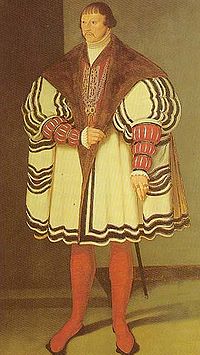 |
Albert VII Albert VII, Duke of Mecklenburg Albrecht VII, the Handsome, Duke of Mecklenburg in Gustrow , was a minor ruler in North Germany of the 16th century... , the Handsome (25 July 1486–7 January 1547) |
1503–1547 | (Son of Magnus II) |
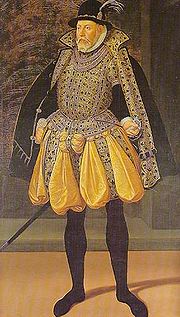 |
Ulrich (5 March 1527–14 March 1603) |
1555–1603 | (Son of Albert VII), initiator of the German Imperial Diet |
| Johann Albrecht II (5 May 1590–23 April 1636) |
1592–1628, 1631–1636 | (Son of Johann VII) | |
 |
Albrecht von Wallenstein Albrecht von Wallenstein Albrecht Wenzel Eusebius von Wallenstein , actually von Waldstein, was a Bohemian soldier and politician, who offered his services, and an army of 30,000 to 100,000 men during the Danish period of the Thirty Years' War , to the Holy Roman Emperor Ferdinand II... (24 September 1583–25 February 1634) |
1628–1631 | Ruled after Adolf Frederick I was deposed by Emperor Ferdinand II Ferdinand II, Holy Roman Emperor Ferdinand II , a member of the House of Habsburg, was Holy Roman Emperor , King of Bohemia , and King of Hungary . His rule coincided with the Thirty Years' War.- Life :... |
| Gustav Adolph Gustav Adolph, Duke of Mecklenburg-Güstrow Gustav Adolph, Duke of Mecklenburg [-Güstrow] was the last ruler of Mecklenburg-Güstrow from 1636 until his death and last Lutheran Administrator of the Prince-Bishopric of Ratzeburg from 1636 to 1648.-Life:... (26 February 1633–6 October 1695) |
1636–1695 | (Son of Johann Albrecht II) | |
Mecklenburg-Schwerin Line (III)
| Name (lived) | Reign | Notes | |
|---|---|---|---|
| Frederick William Frederick William, Duke of Mecklenburg-Schwerin Frederick William I, Duke of Mecklenburg-Schwerin was the reigning Duke in the Mecklenburg-Schwerin part of the territory from 1692 until 1713.... (28 March 1675–31 July 1713) |
1692–1713 | (Nephew of Christian Ludwig I) | |
 |
Karl Leopold (26 November 1678–28 November 1747) |
1713–1728 | (Brother of Frederick William Frederick William, Duke of Mecklenburg-Schwerin Frederick William I, Duke of Mecklenburg-Schwerin was the reigning Duke in the Mecklenburg-Schwerin part of the territory from 1692 until 1713.... ), named in the Reichsexekution of 1717, was deposed in 1728 by the Aulic Council Aulic Council The Aulic Council was originally an executive-judicial council for the Holy Roman Empire.... in Vienna Vienna Vienna is the capital and largest city of the Republic of Austria and one of the nine states of Austria. Vienna is Austria's primary city, with a population of about 1.723 million , and is by far the largest city in Austria, as well as its cultural, economic, and political centre... in favour of his brother Christian Ludwig II. |
 |
Christian Ludwig II (15 November 1683–30 May 1756) |
1728–1756 | (Brother of Karl Leopold) |
 |
Frederick II Frederick II, Duke of Mecklenburg Frederick II, Duke of Mecklenburg[-Schwerin], called the Pious was Duke of Mecklenburg-Schwerin from 1756 to his death.-Early life:Frederick was born at Schwerin, Mecklenburg-Schwerin, son of Christian Ludwig II, Duke of Mecklenburg-Schwerin , and his wife, Duchess... , the Pious (9 November 1717–24 April 1785) |
1756–1785 | (Son of Christian Ludwig II) |
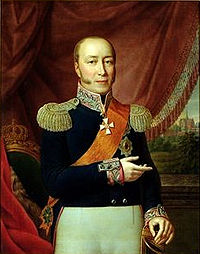 |
Frederick Francis I (10 December 1756–1 February 1837) |
1785–1837 | from 1815 Grand Duke – [Son of Archduke Friedrich Ludwig, Nephew of Friedrich II] |
 |
Paul Frederick (15 September 1800–7 March 1842) |
1837–1842 | (Nephew of Frederick Francis I) |
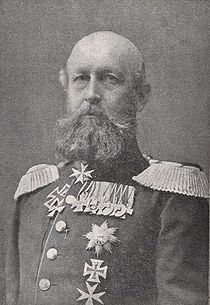 |
Frederick Francis II (28 February 1823–15 April 1883) |
1842–1883 | (Son of Paul Frederick) |
 |
Frederick Francis III (19 March 1851–10 April 1897) |
1883–1897 | (Son of Frederick Francis II) |
 |
Johann Albrecht (8 December 1857–16 February 1920) |
1897–1901 | (Brother of Grand Duke Frederick Francis III), from 11 April 1897 until 9 April 1901 regent |
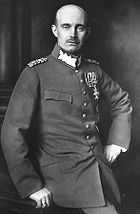 |
Frederick Francis IV (9 April 1882–17 November 1945) |
1897–1918 | (Son of Grand Duke Frederick Francis III), from 1918 Administrator of the Mecklenburg-Strelitz Mecklenburg-Strelitz Mecklenburg-Strelitz was a duchy and later grand duchy in northern Germany, consisting of the eastern fifth of the historic Mecklenburg region, roughly corresponding with the present-day Mecklenburg-Strelitz district , and the western exclave of the former Bishopric of Ratzeburg in modern... District |
Mecklenburg-Strelitz line
| Name (lived) | Reign | Notes | |
|---|---|---|---|
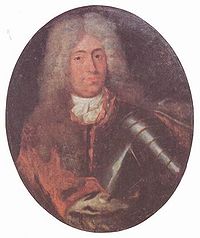 |
Adolf Frederick II (19 October 1658–12 May 1708) |
1701–1708 | |
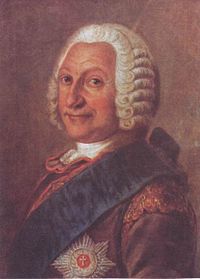 |
Adolf Friedrich III (7 June 1686–11 December 1752) |
1708–1752 | (Son of Adolf Frederick II) |
 |
Adolf Friedrich IV (5 May 1738–2 June 1794) |
1752/53–1794 | (Nephew of Adolf Friedrich III) |
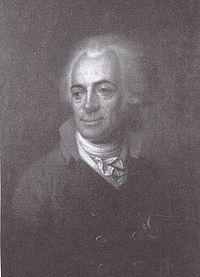 |
Charles II (10 October 1741–6 November 1816) |
1794–1816 | (Brother of Adolf Friedrich IV), from 1815 Grand Duke |
.jpg) |
Georg (12 August 1779–6 September 1860) |
1816–1860 | (Son of Charles II) |
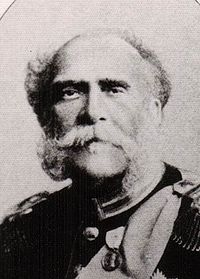 |
Friedrich Wilhelm (17 October 1819–30 May 1904) |
1860–1904 | (Son of Georg) |
.jpg) |
Adolf Friedrich V (22 July 1848–11 June 1914) |
1904–1914 | [Son of Friedrich Wilhelm] |
.jpg) |
Adolf Friedrich VI (17 July 1883–23 February 1918) |
1914–1918 | (Son of Adolf Friedrich V) |
 |
Frederick Francis IV (9 April 1882–17 November 1945) |
1918 | District Administrator |

